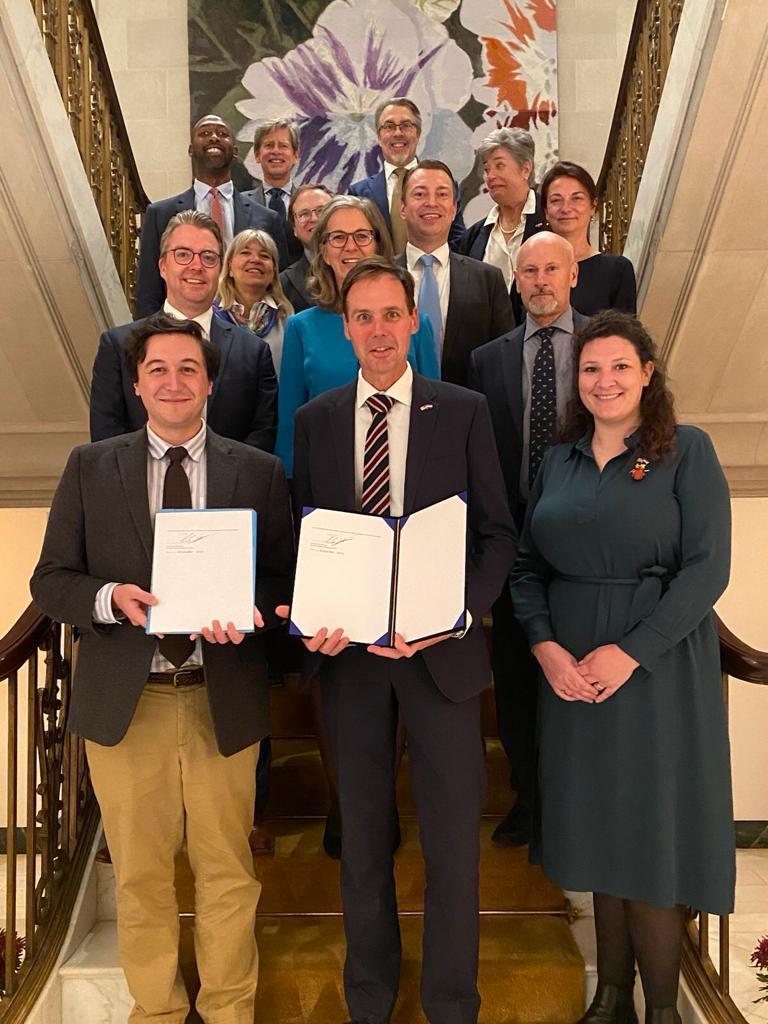Nederland sluit zich aan bij de landen die de waarden en principes onderschrijven in de door NASA opgestelde Artemis-akkoorden. Directeur van het Nederlands ruimtevaartagentschap NSO, Harm van de Wetering, zette daarom deze ochtend in Washington zijn handtekening onder het document, in aanwezigheid van NASA-Administrator Bill Nelson, de Nederlandse ambassadeur Birgitta Tazelaar en Michael Wise als directeur van SRON—het nationale expertise-instituut dat de overheid adviseert en nationale bijdragen aan internationale ruimtemissies coördineert.
Artemis-akkoorden
De Artemis-akkoorden zijn een overeenkomst tussen overheden die direct of indirect deelnemen aan het door de Verenigde Staten geleide Artemis-programma. Dit programma gaat onder andere over exploratie van de maan en Mars, onbemand en later ook bemand. Met de ondertekening onderschrijft Nederland de uitgangspunten van de akkoorden, en geeft het de mogelijkheid voor de Nederlandse ruimtevaartsector in de toekomst ook opdrachten uit te voeren binnen het Artemis-programma.
tien beginselen
De akkoorden bevatten tien beginselen waarin op hoofdlijnen gedeelde uitgangspunten worden beschreven, onder andere op het gebied van internationale samenwerking bij de verkenning van de ruimte, het delen van wetenschappelijke data, het toekennen van rechten voor gebruik van natuurlijke hulpbronnen in de ruimte, en het terugdringen van ruimteschroot. Ook zijn deze richtlijnen bedoeld ter voorkoming van conflicten of misverstanden tussen landen op het gebied van exploratieactiviteiten.
verantwoord gebruik van de ruimte
In die gedeelde uitgangspunten zit volgens Van de Wetering de essentie van de Artemis-akkoorden, ook voor Nederland: “De ontwikkelingen in de ruimtevaart, institutioneel en commercieel, gaan razendsnel en vragen om internationale afspraken over verantwoord gebruik van de ruimte. Nederland heeft de noodzaak van het maken van afspraken altijd erkend en speelt daarom een actieve rol in de ontwikkeling van beleid, regels en voorschriften, zowel in Europees verband als bij de Verenigde Naties”.
nieuwe samenwerkingsgebieden tussen Nederland en NASA
De ondertekening vond plaats tijdens een kleine ceremonie op de residentie van de ambassadeur, in aanwezigheid van een delegatie van NASA, het NSO en enkele vertegenwoordigers van de Nederlandse ruimtevaartsector. Het bezoek van de Nederlandse delegatie werd ook gebruikt voor een verdere verkenning van mogelijke nieuwe samenwerkingsgebieden tussen Nederland en NASA.
brede en diverse samenwerking
De samenwerking met NASA is al breed en divers, en gaat ver terug. Zo was het NASA die de eerste Nederlandse satelliet ANS, volgend jaar precies vijftig jaar geleden, lanceerde. Nederlandse onderzoekers en ingenieurs, zoals die van SRON, leverden belangrijke bijdragen aan NASA-missies zoals de röntgentelescoop Chandra en de James Webb Space Telecope. In december wordt vanaf Antarctica NASA’s Gusto ballontelescoop opgelaten, waarvan de camera’s door SRON en TU Delft zijn geleverd.
aardobservatie
Ook op het gebied van aardobservatie zijn de banden sterk en werden successen geboekt. Zo speelt het Nederlandse Ozone Monitoring Instrument (OMI) op de NASA-satelliet EOS Aura een cruciale rol bij de monitoring van het gat in de ozonlaag. En begin volgend jaar lanceert NASA de aardobservatiesatelliet PACE met daarop het door SRON en Airbus Netherlands gebouwde instrument SPEXone, dat meer kennis moet vergaren over de invloed van aerosolen op klimaatverandering.
zonnepanelen Orioncapsule
Via ESA is er al Nederlandse industrie betrokken bij het Artemisprogramma. Nederlandse zonnepanelen zorgen voor de energievoorziening van de Orioncapsule die mensen naar de maan moet brengen en weer terug. Volgend jaar staat de eerste bemenste vlucht binnen het Artemisprogramma gepland.



